Fix: ‘A Required CD/DVD Drive Device Driver is Missing’ Error Message When Installing Windows 7 from a USB
CDs and DVDs are very quickly becoming obsolete mediums and are being overtaken by USB drives. This is true even in the case of Windows installation media. While it is true that Windows 7 came out during a time where using CDs and DVDs to install Windows was still the norm, the most common Windows 7 installation medium today are USB drives. Almost every person who wants to install Windows 7 on a computer in this day and age uses a Windows 7 installation USB to do so, but being the most commonly traveled road does not mean that it’s not bumpy. When using Windows 7 installation USBs to install Windows 7 on computers, many people have reported seeing an error message at the very beginning of the installation process, an error message that reads:
“A required CD/DVD drive device driver is missing. If you have a driver floppy disk, CD, DVD, or USB flash drive, please insert it now.”
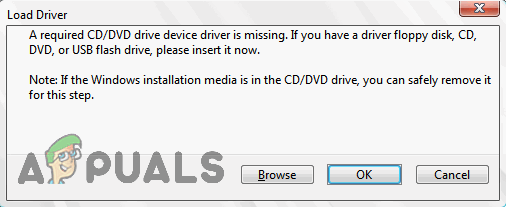
What causes the “A required CD/DVD drive device driver is missing” error message?
Upon seeing this error message, the first thing any affected user would wonder will most certainly be why they’re seeing it in the first place. The error message points at a missing CD/DVD drive device driver, while they’re not using the CD/DVD drive to install Windows 7 in the first place – they’re using a USB drive. Well, that’s just a difference in terminology – the semantics remain the same. This error, in cases other than when it is caused by happenstance or something incredibly generic, is brought on by the use of a USB 3.0 drive to install Windows 7. You see, the Windows 7 installation environment does not have native support for USB 3.0 because the format simply wasn’t all that common back when Windows 7 first came out. That being the case, using a USB 3.0 Windows 7 installation USB or plugging a Windows 7 installation USB into a USB 3.0 port on your computer will result in you seeing the “A required CD/DVD drive device driver is missing” error message when you try to install Windows 7. Even if it doesn’t, in some cases, slow USB 3.0 speeds are caused due to Windows 7 ISO being relatively older than the format and this can also cause errors during the installation.
What causes this issue is not the only thing that’s known, however – its remedies are quite well known too. The following are the absolute most effective solutions you can use to try and resolve this problem, get rid of the “A required CD/DVD drive device driver is missing” error message and successfully install Windows 7 using your Windows 7 installation USB:
Solution 1: Unplug the USB drive and plug it back in
First and foremost, you need to rule out happenstance or some kind of a one-time-only issue with your installation USB or the USB port it is plugged into or some other incredibly generic issue is the reason why you’re seeing the “A required CD/DVD drive device driver is missing” error message when you try to install Windows 7. In order to do so, all you need to do is unplug your Windows 7 installation USB, wait for a little while and plug it back into the USB port. Once done, try booting from the installation USB and installing Windows 7 to see if the error message still persists.
Solution 2: Unplug the USB drive and plug it into a different USB port
You might be seeing the “A required CD/DVD drive device driver is missing” error message when installing Windows 7 from a Windows 7 installation USB because there’s some kind of a problem with the USB port the USB drive is plugged into. If there’s no problem with the USB port, the USB port you’re using might just be a USB 3.0 port, and as stated before, the Windows 7 installation environment simply doesn’t have USB 3.0 support, meaning that it might simply be unable to read the installation files that are on the installation USB. If that’s the case, you can get rid of the error message by simply unplugging the USB drive from the USB port it is plugged into and plug it into a different USB port on your computer. It would help your case a great deal if the USB port you plug the installation USB into is a port you definitely know to be a USB 2.0 port. Also, verify that the USB ports don’t have any power surge issues because that can also interrupt during ISO installation.
Once you have the installation USB plugged into a different USB port, try booting from the installation USB and installing Windows 7 to see if the issue has been fixed.
Solution 3: Disable USB 3.0 Configuration in Pre-OS
On many computers, especially computers that only have USB 3.0 ports, the BIOS has a setting named USB 3.0 Configuration in Pre-OS. This nifty little setting defines whether the USB ports on the computer, before the computer boots into its Operating System, function as USB 3.0 ports or USB 2.0 ports. If you’re seeing the “A required CD/DVD drive device driver is missing” error message while trying to install Windows 7 from a Windows 7 installation USB, you might be able to get rid of the error message by disabling the USB 3.0 Configuration in Pre-OS setting in your computer’s BIOS (or by setting it to Auto, which essentially achieves the same thing we were trying to by disabling it). If you would like to use this solution, you need to:
- Remove the Windows 7 installation USB from the computer and restart it.
- On the very first screen, you see when the computer boots up, press the key specified on the screen to get into your computer’s BIOS or Setup. The key you need to press will be clearly specified on the first screen you see when the computer boots up and varies from one computer manufacturer to the next.
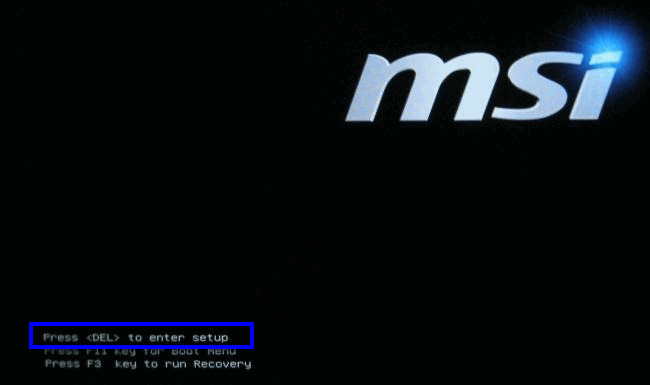
Press [key] to enter setup - Once you’re inside your computer’s BIOS, make your way to System Configuration.
- Locate and navigate to the USB 3.0 Configuration in Pre-OS setting.

Locate the USB 3.0 Configuration in Pre-OS setting - Change this setting from Enabled to either Disabled or Auto, respectively resulting in all USB 3.0 ports on the computer being treated as USB 2.0 ports until the OS is loaded or USB ports, until the OS is loaded, being treated as USB 3.0 or USB 2.0 ports depending on the kind of USB drives that are plugged into them.
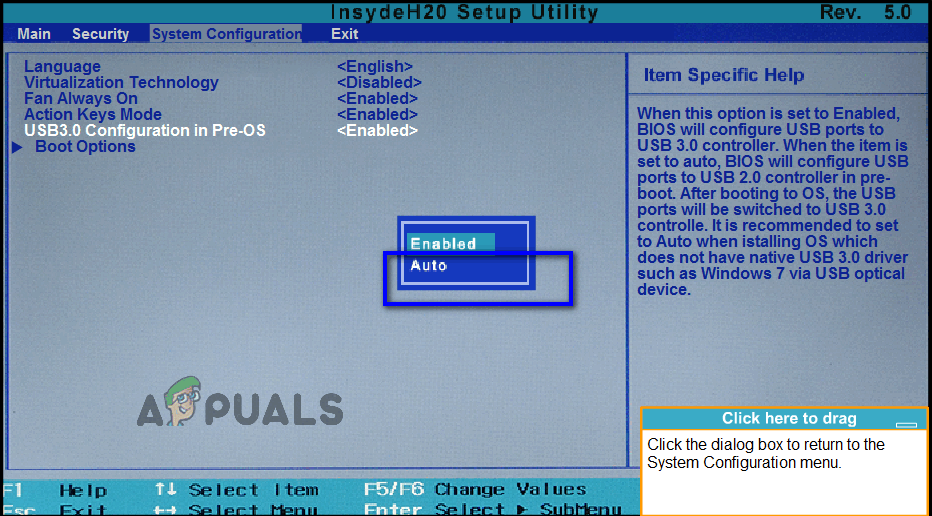
Set USB 3.0 Configuration in Pre-OS to Auto or Disabled - Save the changes you have made and exit your computer’s BIOS.
When you’re done, plug your Windows 7 installation USB back into the computer, boot from it and try to install Windows 7. You should now be able to successfully install Windows 7 without running into the “A required CD/DVD drive device driver is missing” error message. Be sure to set USB 3.0 Configuration in Pre-OS back to Enabled after Windows 7 has been installed.
Method 4: Disable AHCI Mode
If your CD/DVD drive is not compatible with the Microsoft AHCI driver (msahci.sys), your disk controller may be set to AHCI in the system BIOS.
The SATA interface can operate in two modes, IDE and AHCI:
IDE: A compatibility mode for older equipment and software. In fact, in this mode SATA capacity is no different from its predecessor, ATA (or PATA) interface;
AHCI: A new mode for memory devices, where a computer can use all SATA advantages, primarily higher speed of data exchange with SSD and HDD (Native Command Queuing technology, or NCQ), as well as hot-swapping of hard disks. When you activate AHCI mode, it increases the speed of access to files in memory devices and improves the overall performance of your computer.
You may be able to resolve the issue by disabling AHCI mode for your disk controller in the BIOS. There are multiple BIOS manufacturers and BIOS versions, you should check your system documentation or visit your PC manufacturers website for exact instructions on how to change this setting
The basic process for changing the disk controller setting is to restart your computer and entering the system BIOS is as follows.
- Restart your computer and wait for it to shut down completely.
- When the PC is booting up, press the “F2” or the “F12” key repeatedly to get into the computer’s bios.
- Once inside the bios, navigate around it until you come to the Storage controller setting which offers you to select from “AHCI”,”IDE”, RAID or “ATA” mode.
- Make sure to select another option and unselect the AHCI option in this setting.
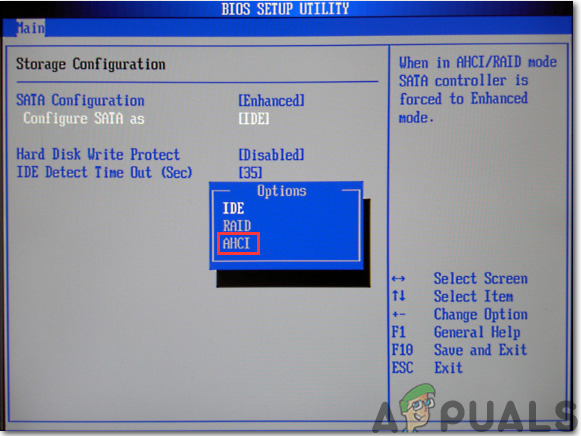
Unselecting this option - Save your changes and reboot the computer.
- Check to see if changing this setting has fixed the issue and if it doesn’t, make sure to try all the other options one by one before you give up on this method.Warning: Incorrect settings in the System BIOS can cause your PC’s function incorrectly. If you are not familiar with configuring the system BIOS, you should contact the PC manufacturer for assistance.
Method 5: Manually Install The IRST Driver (DELL Users Only)
Intel Rapid Storage Technology is a Windows-based application that provides improved performance and reliability for systems equipped with SATA disks for desktop, mobile, and server platforms. When using one or multiple SATA disk drives, you can take advantage of enhanced performance and lower power consumption.
This driver might also be necessary to properly use the motherboard that you are using because intel is known for pushing its motherboard drivers beyond other ones and you might actually be able to fix this issue by installing this driver. In order to install this driver, follow the steps below.
- Download the “Intel Rapid Storage Technology F6 Driver” for Windows 7 64-bit from the Dell Support Website (dell.com/support/home).
- Click the Drivers & downloads link. Ensure that the operating system that you are using is selected from the list of available ones.
- Click the arrow and click the download link for the Intel Rapid Storage Technology F6 Driver.
- Extract and copy the IRST drivers to a USB 3.0 key, double-click the file, and follow the prompts to extract the compressed files.).
- Boot your system to the Windows 7 Professional 64-bit media using the F12 boot menu to select your boot device.
- When you are prompted to load a driver, insert the USB 3.0 key that contains the IRST driver, and install the Intel Rapid Storage Technology Driver.
- The Windows 7 Professional installation should continue now.
Note: If your system does not recognize any USB devices, then you are most likely trying to install Windows 7 to a system with the Skylake Chipset. Downloading the most current Dell Windows 7 ISO or inserting the USB 3.0 driver into your Windows 7 image should resolve the issue.
Method 6: Utilize USB3.0 Creator Utility
The Intel USB 3.0 Creator Utility is a tool for adding USB 3.0 driver support to Windows 7 Installation Media. Most of the users have reported that missing USB3 drivers were the root cause of the issue hence follow the steps indexed below to use the USB Creator Utility for preparing your Flash Drive:
- Make sure to completely shut down your computer.
- Use another computer internet connectivity and then download the “win7-USB3.0-creator-utility.zip”. After download, you may unzip the zip file if you want. Click here to download the win7-USB3.0-creator-utility.zip Note: Check out more alternative utilities to install missing drivers of Windows 7 bootable USB.
- Extract the zip file and Run this “Installer_Creator.exe” file which is located inside the zip file.
- Click on “Yes” and Windows will ask for your permission to run this file. Please allow it to run. After allowing it, the “USB 3.0 driver creator utility” will open up in front of you.
- Click on the browse button (3 dots) icon and then select the USB drive (Windows 7 bootable USB drive).
- Click on OK
- Click on the “Create Image” After clicking, it will start installing. It will take time, so please wait for its finish message “Update Finished”. After getting this finished message, you may close the utility and take out the USB drive (flash drive) from the computer.
Now, your USB drive is ready and loaded USB 3.0 drivers. You may use this USB drive to install Windows 7 even on the new generation’s computers. - Put this USB drive to the computer where you want to install Windows 7 OS. Put this Windows 7 bootable drive to another USB port of the computer and don’t plug it into the same port where you were connected it last time.
- Boot your computer through the USB drive and hopefully, the issue would’ve been resolved until now.
Method 7: Make a bootable USB Drive With Windows Utility Program
Numerous users reported that they were able to get around this issue by burning the ISO files again on the USB Drive with the help of the Windows Utility Program. Hardly any commercial USB drives are suitable from the outset for these diverse tasks. This is because most models are only loaded with a single file system when you first get them, for example, a FAT32 or exFAT file system. You can simply use the cmd.exe application, better known as “Command Prompt”, to create a bootable USB drive on all operating systems from Windows Vista (including Windows 10). This goes as follows:
- Plug the USB drive into your computer’s USB port.
- Search for the “cmd” application in the Windows start menu, right-click on the item, and select “Run as administrator” from the context menu. This opens a small window with white text on a black background.

Running cmd as Administrator - Type the command “diskpart” and confirm your input with the enter key (you’ll also do this after every other entered command). This starts the storage device manager.
- Enter the command “list disk” to display all available storage devices.
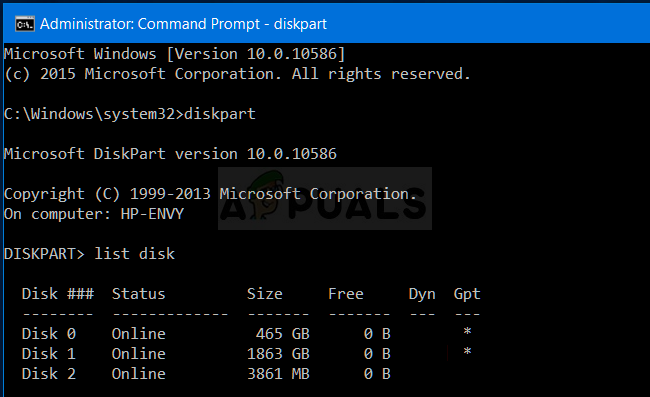
Listing available disks in DISKPART - You can recognize your USB by its storage capacity, and it’s usually listed as “disk 1”. In the system partition, “disk 0” is usually your PC, so a hard drive or solid-state drive in your computer.
- Based on the assumption that your USB has the label “disk 1”, enter the command “sel disk 1” to select it (or the corresponding “disk 2”, etc.).
- Enter the command “clean” to delete all files from the USB.
- Enter the command “create partition primary” to create a main partition.
- Enter the command “list par” and select the newly created main partition with “sel par 1”.
- Activate the partition with the command “active”.
- Format the USB with the command “format fs=FAT32 label=“WINDOWSUSB” quick override” (in place of “WINDOWS USB” you can also choose another label, so long as it doesn’t contain any spaces or special characters. The drive will later be displayed under this name if you plug into a running Windows computer). Formatting may take a while and you can track its progress in the percentage bar.
- As soon as the process is finished, enter the command “assign” to automatically assign a drive letter (for example “G:”) to your USB.
- Enter “exit” to close DiskPart, and then “exit” again to close the command prompt.
- To finish the process, you just have to copy the Windows ISO file to a bootable USB stick. This is done with a basic drag-and-drop. Note: If you’re using an installation disc, you can also drag all setup files from there onto your drive (use the folder options to display all of the hidden files first). That’s all possible in the command prompt as well. For a source media with the drive letter “D:” and a USB drive with the letter “G:”, the corresponding command would look as follows: “xcopy D:\*.* G:\*.* /S /E /F” (all of the spaces are intentional).
- Now, restart your system, boot from the USB, and try to install Windows 7. Hopefully the error would’ve been rectified.
Method 8: Inject USB3 Controller Drivers into boot.wim
Judging from the error description, you might be tempted to find and add the storage controller to the boot.wim file which contains the WinPE environment. When performing the installation from USB, what Windows Setup needs to have is in fact the USB Controller drivers to access the installation source files. The error message was solved by injecting the USB3 controller drivers into boot.wim, using the following steps:
- Copy the boot.wim file containing the Windows Setup PE from the installation media to D:\Temp.
- Download the USB3 controller drivers from the laptop manufacturer’s website and then extract the drivers (cat/inf/sys files, not the setup.exe!) from this installation package. Afterward, copy the drivers to the following directory:
D:\Temp\drivers.
- Now, create a temporary mounting point directory at the following location:
D:\Temp\Mount.
- Mount the WIM file using the command indexed beneath:
dism /mount-wim /wimfile:D:\TEMP\boot.wim /index:2 /mountdir:D:\TEMP\mount
- Afterward, inject the USB3 hub drivers using the following commands one by one respectively:
dism /image:"D:\Temp\mount" /add-driver /driver:"D:\Temp\drivers\USB3\nusb3hub.inf"
- Then add the USB3 host controller drivers using the commands stated below:
dism /image:"D:\Temp\mount" /add-driver /driver:"D:\Temp\drivers\USB3\nusb3xhc.inf"
- With the drivers added, unmount the WIM image and commit all changes to the image:
dism /unmount-wim /mountdir:D:\Temp\mount /commit
- Copy the boot.wim image back to the USB installation media and reboot the laptop and install Windows.
Method 9: Use the GigaByte Utility
In order to install Win7 on a Skylake-based (or newer) machine which has a CPU that MS still supports Win7 for, you must recreate new Win7 installation media (e.g. new bootable USB flash drive) which includes required USB 3.0 drivers because USB mouse/keyboard is supported by USB 3.0 in SKylake or newer chipsets. These necessary USB 3.0 drivers are not present in the original Win7 installation media. Same also is true for NVMe drivers (either for Intel or Samsung) if you wanted to install Win7 to an NVMe target SSD, as these required NVMe drivers are also missing from the original Win7 install media.
The easiest and most reliable way to create usable bootable USB media to install Win7 with the required USB 3.0 driver (and optionally also the required NVMe drivers) present is to use the Gigabyte USB Installation utility program, developed several years ago to support their own users who’d bought Gigabyte motherboards based on the Intel 100 Series chipset.
The Gigabyte utility is available from the Gigabyte download site, scrolling down on the page and expanding the “Utilities” category. It is described as: Windows USB Installation Tool, (Note) Support Intel 100/200/X299 series motherboards. OS: Windows 7 64bit,Windows 7 32bit. The direct link to the utility on that page is here.
Simply run the utility, specify the source Win7 installer (either CD/DVD or mounted ISO file), specify the output device (e.g. 8GB or larger USB flash drive), and check USB 3.0 driver and optionally NVMe driver. You should uncheck the third “packages” box, which will for some reason automatically click on if you check the NVME second box. The utility will slipstream the missing requested drivers along with the original Win7 media into a new bootable USB flash drive that you can then use to install Win7 to a Skylake or newer machine.
IMPORTANT NOTE: After you download the ZIP file, before unzipping it you must turn off the BLOCKED security flag that is present. Unless you first remove the security flag before unzipping, the result of unzipping will be to prevent the expanded files from being accessible when you actually run the Gigabyte utility (which also is one of the files embedded in the ZIP file), and it will end abnormally with an error message about “unable to add drivers…”.
To solve the problem right-click on the ZIP file, select Properties, and you will see the Security item at the bottom of the General tab. Push the UNBLOCK button, then APPLY/OK, and now you are free to unzip this ZIP file. All of the expanded files will now be perfectly readable by the Gigabyte utility, and the process of adding USB 3.0 (and optionally NVMe) drivers to the original Win7 CD/DVD or ISO installer media to create new output bootable USB flash drive will run to normal completion.
Method 10: Disable Driver Signature Enforcement
Driver signing enforcement ensures that only drivers that have been sent to Microsoft for signing will load into the Windows kernel. This prevents malware from burrowing its way into the Windows kernel. Some users disabled driver signing and they were able to get around this problem after performing this step. After performing this step you’ll be able to install drivers that aren’t officially signed. Be sure you know what you’re doing and you should only install drivers you trust. Follow the steps indexed below to disable driver signature:
- Restart the computer and wait for it to shut down completely
- Power the computer back on and at startup, press, and tap the F8 key about every second until you see the Advanced Boot Options.
- When the menu pops up, use the Down arrow key to scroll to “Disable driver signature enforcement” and press “Enter”. Continue the boot process.

Disable driver signature enforcement.
NOTE: This is a temporary solution. You have to repeat the process every time you want to use unsigned drivers.
Disable Driver Signature Enforcement Permanently:
You can try commands to disable driver signature enforcement permanently and completely.
- Press “Windows’ + “R” to open the Run prompt.
- Inside the run prompt, type in “cmd” and press “Shift” + “Ctrl” + “Enter” to launch with admin permissions.
- Type the following commands one by one and press the Enter key:
bcdedit /set testsigning on bcdedit.exe -set loadoptions DDISABLE_INTEGRITY_CHECKS bcdedit.exe -set TESTSIGNING ON
Note: You should receive the “The operation completed successfully” message.
- Closeout of the command prompt now and you should be able to install any drivers without requiring a digital signature.
Method 11: Recreate Your VM
Some people suggested that the iso file worked completely fine and this issue arose on their systems when they updated their Parallels. Some reported that the issue was still there until they realized they were trying to install with the VM of the previous version. When they deleted the older one and created a new one it worked. So if you are reading this, just update your Parallels, delete your VMs and start over, don’t worry about configuration, just make sure you start fresh.
- First of all delete your actual VM from your system.
- Afterward, update your Parallels Desktop. For example, it could be 8.0.18608 or something like that.
- Create the VM using a brand new downloaded ISO file. You can use a download manager like ex. Folx etc.
- Lastly, recreate your VM and hopefully, the issue would be rectified.
Method 12: Download SATA Drivers (For HP Users Only)
If you installing from the OEM disc that came with the computer then it might be causing the issue. HP is notorious for proprietary SATA drivers. If you cannot find the original OEM disc, then proceed to HP’s web site and download the SATA drivers and put them on a USB drive. Click the browse option and it will let you select the driver from a USB drive. That should be all you need to do.
Method 13: Contact Customer Support
Some computer geeks reported that this error commonly occurs when the Windows 7 DVD or the ISO image used to create said DVD, is corrupted. The best workaround for this issue is to re-download the Windows 7 ISO image to use with Parallels. Also re-burn the new ISO image to DVD if you still need a physical disc (for Boot Camp).
If this error occurs with a retail DVD you can ask for a replacement or check that your optical drive is in full working order (having tried using a CD/DVD lens cleaner on it first).
Method 14: Check Hardware Faults
Another efficient remedy to this problem is to remove the DVD media and check for scratches, cracks or smudges that may make the DVD difficult to read if the media is scratched or cracked, you must get replacement media. If the DVD is dirty or smudged, clean the DVD with warm water and a soft cloth. Be sore the DVD is completely clean and dry before re-inserting into the CD/DVD drive. Next, restart the computer and press any key when you are prompted and start Setup.
Workaround: If you still can’t get rid of this issue then the last thing left for you is to burn ISO image to DVD because this error appears just with a USB stick. In case you want to use a USB stick then examine the USB stick’s light. You’ll observe that whenever the error occurs that light blinks harmonic. Therefore, try to pull and push the USB stick slowly and smoothly in its hub a couple of times. After doing this you will see that the light will start blinking continuously and this error will go away soon. Keep one thing in mind that don’t apply too much force on the stick, just pull and push it very carefully




